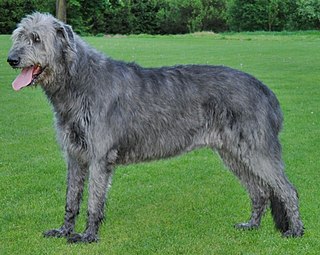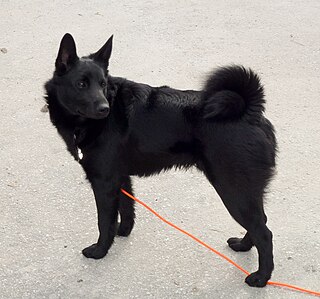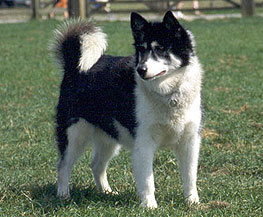
The Irish Wolfhound is an Irish breed of large sighthound and one of the largest of all breeds of dog. The modern breed was developed in the late 19th century by G.A. Graham, whose aim was to recreate the extinct Irish wolfhounds of Ireland. Classified by recent genetic research into the Sighthound United Kingdom Rural Clade, the breed is used by coursing hunters who have prized it for its ability to dispatch game caught by other, swifter sighthounds. In 1902, the Irish Wolfhound was declared the regimental mascot of the Irish Guards.

A dog breed is a particular type of dog that was purposefully bred by humans to perform specific tasks, such as herding, hunting, and guarding. Dogs are the most variable mammal on Earth, with artificial selection producing upward of 360 globally recognized breeds. These breeds possess distinct traits related to morphology, which include body size, skull shape, tail phenotype, fur type, body shape, and coat colour. However, there is only one species of dog. Their behavioral traits include guarding, herding, and hunting, and personality traits such as hyper-social behavior, boldness, and aggression. Most breeds were derived from small numbers of founders within the last 200 years. As a result, today dogs are the most abundant carnivore species and are dispersed around the world.

The Swedish Vallhund, also known as the Västgötaspets and Swedish cow dog, is a breed of dog native to Sweden. The breed's name, Vallhund, when translated into English, means herding dog, as the Swedish Vallhund was originally bred as a drover and herder of cows over 1,000 years ago. In 1942, the dog came close to extinction, but careful breeding and publicity by Swedish national Björn von Rosen and K. G. Zettersten managed to revive the breed in popularity and save it from its likely end. In 1943, the Swedish Kennel Club recognized the Swedish Vallhund as a breed, and officially categorized the Swedish Vallhund as "the Västgötaspets" for Västergötland, the province in which their revival took place. Since then, the breed has been recognized by, and bred in, over ten countries and has gained some popularity.

The Jämthund, also called the Swedish Elkhound, is a breed of dog of the Spitz type that is found in Northern Europe. The Jämthund is eponymous with Jämtland, a province in the middle of Sweden.

The Saarloos Wolfdog is a wolf-dog breed originating from the Netherlands by the crossing of a German Shepherd with a Siberian grey wolf in 1935. The offspring were then further crossed with German Shepherds.

The Finnish Spitz is a breed of dog originating in Finland. The breed was originally trained to hunt all types of game from squirrels and other rodents to bears. It is a "bark pointer", indicating the position of game by barking, and drawing the game animal's attention to itself, allowing an easier approach for the hunter. Its original game hunting purpose was to point to game that fled into trees, such as grouse, and capercaillies, but it also serves well for hunting elk. Some individuals have even been known to go after a bear. In its native country, the breed is still mostly used as a hunting dog. The breed is typically friendly and good with children, so it is suitable for domestic life. The Finnish Spitz has been the national dog of Finland since 1979.

The Karelian Bear Dog is a Finnish breed of dog. In its home country, it is seen by many as a national treasure. Karelian Bear Dogs will hunt a variety of animals. Its quick reflexes and fearless nature have made it very popular for hunting large game including brown bears, moose, and wild boar. It was the breed's ability to hunt bears that earned the breed its name. The Karelian Bear Dog is among the top 10 most common dog breeds in Finland.

The Norwegian Buhund is a breed of dog of the spitz type. It is closely related to the Icelandic Sheepdog and the Jämthund. The Buhund is used as a watch dog and an all purpose farm and herding dog.

The Carolina dog, also known as a yellow dog, yaller dog, American dingo, or Dixie dingo, is a breed of medium-sized dog occasionally found feral in the Southeastern United States, especially in isolated stretches of longleaf pines and cypress swamps. Efforts to establish them as a standardized breed have gained the Carolina Dog breed recognition in two smaller kennel clubs and full acceptance into the breed-establishment program of one major kennel club.
Canid hybrids are the result of interbreeding between the species of the subfamily Caninae.

The Finnish Lapphund is a hardy, easy going, medium-size breed of Spitz type. Traditionally it has been used for herding reindeer. Although it is one of the most popular dog breeds in its native country, Finland, it is not very numerous outside of the Nordic countries.
Elkhounds are a group of Fennoscandian dog breeds belonging to the Spitz-type dogs and used for hunting elk/moose and other large animals.

The Lapponian Herder is a breed of dog from Finland, one of three Lapphund breeds developed from a type of dog used by the Sami people for herding and guarding their reindeer.

The Black Norwegian Elkhound is a small Spitz breed classified by the FCI as a hunting dog. It is currently an uncommon breed in Norway and very rare outside the Nordic countries of Scandinavia. It is a sibling breed to a Grey Norwegian Elkhound, but is smaller, more agile, doesn't bark and was bred explicitly for on-leash dog hunting.

The Swedish Lapphund is a breed of dog of the Spitz type from Sweden, one of three Lapphund breeds developed from a type of dog used by the Sami people for herding and guarding their reindeer. The expression "the black beauty of Norrland" is very often attributed to the Swedish lapphund, which is most likely one of Sweden's oldest breeds.

A bay dog is a dog that is specially trained to find, chase, and then bay, or howl, at a safe distance from large animals during a hunt, such as during a wild boar hunt.

A jackal–dog hybrid is a canid hybrid resulting from a mating between a domestic dog and a golden jackal. Such crossbreeding has occurred numerous times in captivity and was first confirmed to occasionally happen in the wild in Croatia in 2015.

Hällefors Elkhound is a Swedish dog breed.

Native American dogs, or Pre-Columbian dogs, were dogs living with people indigenous to the Americas. Arriving about 10,000 years ago alongside Paleo-Indians, today they make up a fraction of dog breeds that range from the Alaskan Malamute to the Peruvian Hairless Dog.

The Lài dog, is a distinct landrace of dogs native to the northern mountains of Vietnam, but also sometimes used ambiguously to refer to any indigenous landrace of Vietnam including the Indochina dingo. It is considered to be one of Vietnam's four great national dogs, and the only one that is not recognized by the Vietnamese Kennel Club. The Lài dog is indigenous to the highland areas west of Thanh Hóa along the Mã River and in some remote villages in the northern border area where they function as a farm dog, providing pest control around the house, herding cattle or hunting for food in the forest. Today, this landrace is critically endangered with only a few hundred remaining.





















